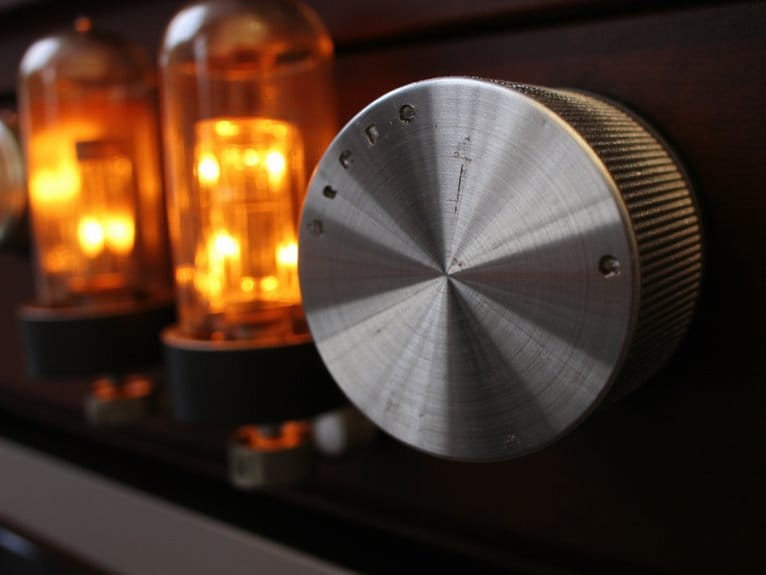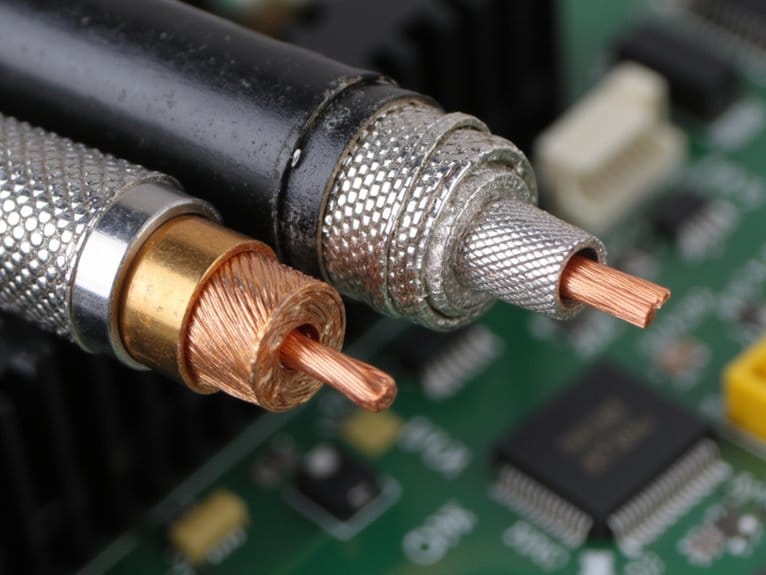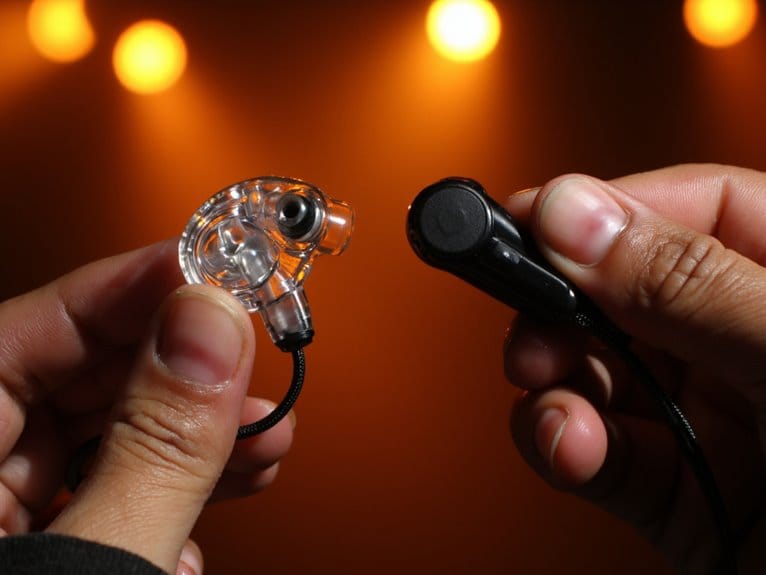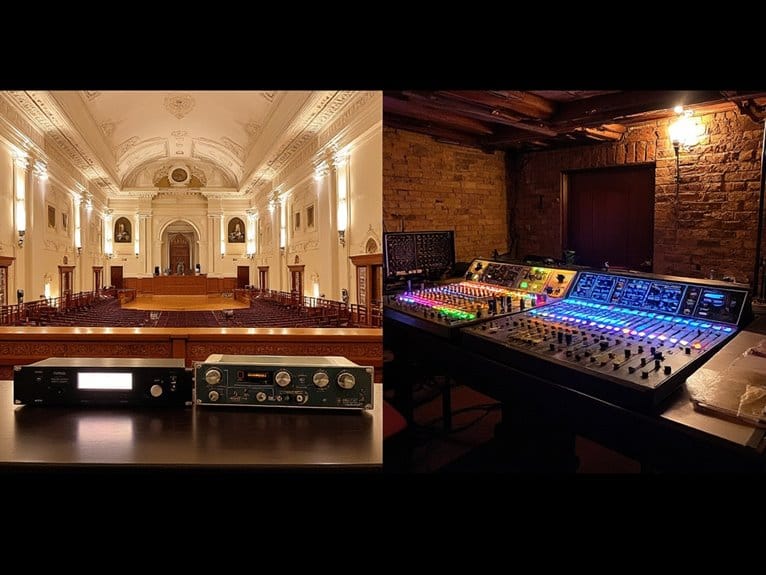Power Scaling and Attenuators: Controlling Volume Without Losing Tone
Power scaling technology, developed by Kevin O’Connor, modifies voltage and current stress on your amp’s output tubes to achieve natural overdrive at bedroom volumes while preserving tone fidelity and dynamic range. Unlike traditional master volume controls that reduce signal before hitting power tubes, or speaker attenuators that work post-amplification and introduce coloration, power scaling directly controls tube output for superior tonal consistency. Understanding the technical implementation challenges reveals why this approach outperforms conventional methods.
We are supported by our audience. When you purchase through links on our site, we may earn an affiliate commission, at no extra cost for you. Learn more.
Notable Insights
- Power scaling modifies voltage and current stress on output tubes, maintaining tone fidelity across all volume settings.
- Traditional master volumes reduce signal before power tubes, while attenuators work post-amplifier, both introducing unwanted tone coloration.
- Power scaling preserves dynamic range and harmonic distortion characteristics without compression, unlike conventional volume control methods.
- Implementation requires careful bias regulation and drive compensation adjustments, making it more complex than simple external attenuators.
- Power scaling proves most effective in amplifiers under 50 watts, offering superior tonal consistency compared to traditional methods.
Understanding Power Scaling Technology and Its Core Principles
When you’re chasing that perfect tube amp tone at bedroom volumes, you’ll quickly discover that traditional approaches like master volume controls and simple attenuators fall frustratingly short of delivering the rich, dynamic sound you’re after.
Power Scaling technology, developed by Kevin O’Connor of London Power, fundamentally changes this equation by modifying voltage and current stress on your output tubes rather than simply reducing power output. This approach maintains tone fidelity by preserving your amplifier’s compression point and touch sensitivity across all volume settings.
Unlike conventional methods that compress your dynamic range, Power Scaling enables broader dynamics while keeping that essential tonal character intact, allowing you to access fully saturated distortion and harmonic richness at whisper-quiet levels.
How Power Scaling Differs From Master Volume Controls and Speaker Attenuators
While most guitarists instinctively reach for their amp’s master volume knob when they need to turn down, I’ve found that understanding the fundamental differences between master volumes, speaker attenuators, and power scaling can dramatically change how you approach tone shaping at different volume levels.
Your master volume sits between preamp and power amp stages, reducing signal before it hits the power tubes, which often creates sharper, less natural overdrive when you’re pushing preamp gain while keeping volume low.
Master volume reduces signal before power tubes, creating sharper, less natural overdrive when pushing preamp gain at low volumes.
Speaker attenuators work after your power amp, preserving tube saturation but introducing some tone coloration through signal dissipation.
Power scaling operates differently, modifying power tube output directly while maintaining full dynamic response and natural compression characteristics across all volume levels, offering superior tonal consistency. Just as professional-grade preamps in affordable audio interfaces can deliver high-quality results without compromising signal integrity, proper volume control methods preserve the essential character of your amplifier’s tone at any output level.
Similar to how professional DI boxes use input attenuation options to handle high-output signals without distortion, these volume control methods each manage signal levels at different points in your amplifier’s chain.
Preserving Output Tube Distortion and Harmonic Characteristics at Low Volumes
The holy grail of tube amplifier design lies in capturing that sweet spot where your power tubes generate their characteristic harmonic distortion without rattling the windows or earning you noise complaints from neighbors.
Achieving this requires understanding how nonlinear transfer curves continue producing musically pleasing harmonics even at reduced power levels, though maintaining quality depends heavily on proper tube biasing and balanced operation.
- Proper tube biasing guarantees symmetrical clipping – preventing harsh distortion artifacts that plague poorly maintained amplifiers
- Balanced push-pull operation – keeps both output tubes working harmoniously instead of fighting each other
- Power scaling maintains saturation dynamics – allowing tubes to reach their sweet spot while reducing actual speaker output
- Warm, stable tubes produce consistent harmonics – cold or weak tubes sound lifeless and unmusical
- Quality attenuators preserve frequency response – cheap solutions often muddy your carefully crafted tone
Practical Implementation and Audio Power Considerations for Guitar Amplifiers
Understanding these harmonic preservation principles sets the stage for examining how power scaling actually works in real-world amplifier circuits, where you’ll encounter specific implementation challenges that separate successful installations from disappointing retrofits.
Practical integration requires technical considerations beyond simple voltage reduction. You’ll need tracking bias regulators for fixed-bias amps, drive compensation adjustments, and careful phase splitter supply management to maintain tonal integrity.
| Implementation Aspect | Traditional Method | Power Scaling |
|---|---|---|
| Power Reduction | External attenuators | Internal voltage scaling |
| Heat Generation | High dissipation | Minimal heat increase |
| Tube Stress | No voltage reduction | Reduced operating stress |
| Compatibility | Universal | Amp-specific integration |
Most retrofits demand rebuilding bias supplies or converting rectifier circuits, particularly in amplifiers under 50W where power scaling proves most effective for preserving cranked-amp tone characteristics.
On a final note
You’ve now got the knowledge to make informed decisions about volume control solutions for your tube amp. Whether you’re choosing power scaling, traditional attenuators, or master volume controls, you’ll understand the trade-offs between convenience, tone preservation, and cost. I’ve found that each approach has its place, and honestly, the “best” solution depends on your specific needs, budget, and how critical that cranked-tube sound is to your playing.







